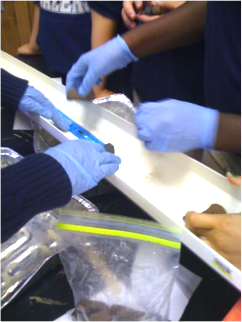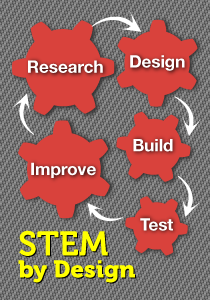The 10 Essential STEM Teaching Practices
Many of my middle school students were natural scientists. They loved to explore, invent, build, figure things out and be actively engaged in their learning.
While they would tolerate working with a fake scenario (“A space alien has just landed and . . .”) they were most engaged when dealing with problems that real scientists and engineers were working on.
Environmental issues were among their favorites; they wanted to make the world a better place.
That’s reason enough to be a STEM advocate! Kids need a place where they can get together to learn how to approach and solve problems they care about.
Looking beyond the 3 R’s, in today’s connected world students must become proficient in the 4 C’s: Creativity, Critical thinking, Collaboration and Communication. Mindy Curless, a Kentucky STEM initiatives consultant, asserts that “Developing these skills is a natural outcome of a STEM curriculum and perhaps the best reason to engage students in these experiences.”
Students in Flux
 Few teachers would dispute that students are changing and the world is changing. When I began teaching, I noticed an interesting phenomenon. It seemed that every two or three years my latest batch of 12- and 13-year-old students arrived with a whole new mindset and outlook – a different set of interests and skills and a different way of thinking and reacting.
Few teachers would dispute that students are changing and the world is changing. When I began teaching, I noticed an interesting phenomenon. It seemed that every two or three years my latest batch of 12- and 13-year-old students arrived with a whole new mindset and outlook – a different set of interests and skills and a different way of thinking and reacting.
If I were going to be successful in helping them learn, I had to continually evolve – to change my way of teaching to meet their learning styles and needs.
As I continued teaching into the 21st century, I noticed another odd thing; in our high-tech, fast-paced, and connected world, my students were in a continual state of flux. I had to change faster. I had to develop new teaching skills and beliefs about what constitutes good teaching.
That kind of continual change is a tall order for any middle level teacher, much less a teacher who is called upon to integrate STEM content and techniques into the curriculum. Continual change means ongoing learning to develop new teaching skills and new ideas about what it means to BE a teacher.
10 Essential STEM Teaching Practices
Here are some aptitudes and proficiencies that seem to be valuable for the STEM teachers – or for any middle level teacher who wants to be cutting-edge.
1. Believe in your students. For your sake and the sake of your students, set high expectations for your students, challenge them to succeed, and believe that they will. Most students will perform at the level you expect, so trust them to make informed choices about their engineering challenges, come up with creative solutions, complete complex tasks, and work together smoothly to do so.
2. Transfer control of the learning process to the students. Develop new roles and rules that stress student responsibility. Check out this article for ideas on how to accomplish this. Then guide from the sidelines while keeping students on target with their direction and purpose. Aim at helping them become self-sufficient learners.
3. Foster curiosity. Learn the art of asking open-ended questions with plenty of possible answers. Pose problems rather than answers and send students on a search for solutions. Use discrepant events to intrigue students and draw them into the problem. This article suggests six strategies for piquing curiosity so that students engage in using critical thinking skills to solve problems.

5. Increase collaboration among students. Get comfortable with teamwork. Actively teach teamwork skills and work with students to heighten awareness of their team behaviors and ways of interacting in the class. Here is a link to a student teamwork guide that you may find useful. Feel free to download and use it.
6. Accept failure – both yours and the students – as a necessary part of learning and growing. That is, accept failure that accompanies taking a risk and experimenting, knowing that they might not get it right. Everyone in the classroom should feel safe in taking risks. I tell students that we learn more from what we do wrong than from what we do right, and engineers learn from their mistakes. In fact, failure is a necessary part of learning. If you aren’t comfortable with this idea, you might check out this online commentary.
7. Be an inspiring leader and role model for your students. Be positive and enthusiastic about what students are learning and how they are learning it. Be passionate in your teaching and your love of your subject area.
8. Accept some drawbacks. STEM education will improve student engagement, critical thinking skills, and workforce skills. But it may also play havoc with the lesson plan you wrote and make it more difficult to cover content benchmarks in a stepwise process. In the STEM classroom, you’ll need to be flexible and ready to make some quick shifts in your thinking. You may also need to be willing to deviate from your lesson plan, depending on the direction the students’ investigations and decisions take them.
9. Evolve and grow as a learner. One of the most important things you can do, as a STEM teacher, is to pay attention to the art of teaching. Develop your skills in facilitating (as opposed to dictating) so that students focus on learning how to think like engineers. Embrace digital tools and technology in the classroom with help from your students. (They will enjoy being in the role of teaching you!)
10. Learn in community. Work with your colleagues to study effective ways of teaching STEM lessons. Research shows that as you work with other teachers in Professional Learning Communities you can expect the following results:
• You will increase your engagement with STEM content and how to teach it.
• You will learn more STEM content.
• You will feel better prepared to teach STEM content.
• You will enhance your inquiry-oriented teaching methods.
• You will pay more attention to students’ reasoning and understanding.
Teaching STEM in the fabulous middle grades is an adventure trip with a great destination. I must say that I envy my colleagues who are just beginning to make that journey!
































Is there any information out there regarding teaching through robotics and STEM?
We created a program called “STEM Expeditions” which features robotics and STEM. Our blog: http://naplsstemx.blogspot.com/
Robotics and STEM is very “hot” right now and robotic classes in HS is catching on quick. Anyway, there is a lot of information out there, just start googling.
A lot is going on in the field of robotics and STEM. Robotics is big – from state student competitions to after school programs. Some classrooms have gotten funding to buy equipment for an after-school robotics club.
I wish we had funding and time during the school day for all students to engage in robotics as one way of implementing STEM curricula. One especially intriguing K-12 program is by Carnegie Mellon University Robotics Academy. Google that, and you’ll see great possibilities. However, as usual, the bottom line is funding for robotics academies.
If you locate anything especially intriguing in your investigations, how about letting us know about it.
Salut! Le problème de l’approche STEM est comment on intégre les matières dans un seul projet technique (technologique) par exemple. (Hi! The problem with the STEM approach is how we integrate the materials into a single technical (technological) project, for example.)
Merci infiniment